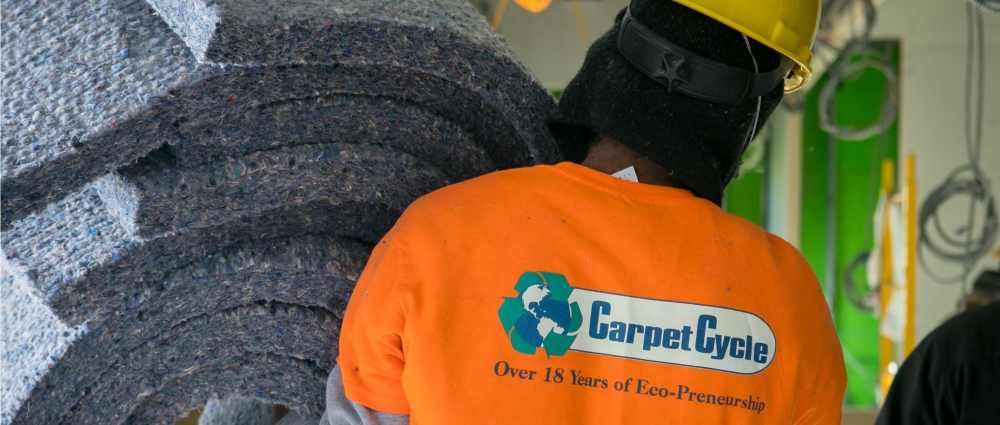Recycling 101
Today, CarpetCycle is lightening the heavy burden on our nation's landfills with innovative recycling technology that has helped divert more than 200 million pounds of carpet since the company's inception. Learn more about our processes and how we can reduce the building industry's eco-footprint together:
- Why is there a difference between Commercial and Residential carpets?
In general, commercial broadloom carpet tends to contain glue and patch residue making it more difficult to get value from the post-consumer material. However, more and more projects are using carpet tiles, which by in large can be recycled or reused.
Residential carpet generally does not have the patch or glue which can adversely affect our machinery. Most houses also have rebond pad which is 100% recyclable. And since we harvest the Nylon fibers, the typical "shag" carpet found in many homes provides more value from recycling than the thinner material found in your average office.
At this time we have limited capacity to recycle broadloom carpet, and are no longer offering drop-off services.
- What sustainable services does CarpetCycle offer?
CarpetCycle, an innovator in post-consumer recycling solutions, provides LEED-accredited opportunities to safely collect tear-out and recycle commercial and residential carpet to reduce the materials' harmful effect on landfills. We also recycle ceiling tiles, gypsum wallboard, fluorescent lights and VCT floor tile to further reduce environmental impact. Visit our services page to learn more.
- What happens when post-consumer commercial and residential carpet is brought back to CarpetCycle's facility?
Once post-consumer carpet is returned to our facility, it is sorted by face fiber and backing type, including Nylon 66, Nylon 6 and polypropylene, before it is processed in CarpetCycle's innovative shearing system to achieve 99-percent nylon purity. With this technology, carpet can be safely recycled or reused as diverse end-use products.
- What new products are created from recycled carpet and post-consumer building materials?
Once processed through CarpetCycle’s separation system, carpet materials can be given “second life” as new carpet yarns for clothing and textiles, auto parts and even racetracks.
Through recycling, CarpetCycle also ensures post-consumer building materials can be reused as new product, transforming:
- Old ceiling tiles into new ceiling tiles;
- Gypsum wallboard into new wallboard or for use within cement manufacturing;
- Post-consumer fluorescent lights into reusable glass, metal end-caps, powder and mercury; and
- Used VCT floor tile into new flooring.
CarpetCycle has begun manufacturing Quiet-Tech insulation, made with post-consumer carpet. Check out the Quiet-Tech page for more information on this sustainable product.
- Does CarpetCycle provide recycling certificates for LEED projects?
Yes. Upon request we can provide a recycling certificate or a detailed letter of indemnification that can be used for LEED certificatuion. On larger projects we can provide detailed reports by material type including weight tickets.
- Where is CarpetCycle located?
We are located in Roselle, New Jersey
360 West 1st Ave, Roselle, NJ 07203 (Google Map)
- How do our clients benefit from using CarpetCycle's recycling services?
When customers think about CarpetCycle they often think “value.” That’s because we not only provide the commercial building industry (real estate owners, facility managers, architects and flooring manufacturers) with cost-effective reclamation services affording up to 60-percent in cost savings versus demolition contractors, but also services that help build its customers’ reputations as sustainable advocates, whether through LEED-accreditation or word of mouth, for a significant ROI. Through our residential recycling services, CarpetCycle helps reduce heavy waste management tax rates incurred by “curbing” carpets by providing a sustainable alternative.
“With no impact to cost or schedule, SL Green has proven that recycling of carpet and ceiling tile can be successfully integrated within all construction projects, whether 500, 50,000, or 500,000 square feet.” Jason Black / SL Green (article)
- How can CarpetCycle customers qualify for LEED accreditation?
-
By partnering with us to recycle post-consumer carpet, you can earn up to two LEED credits through LEED for Existing Buildings (LEED-EB) and LEED for Commercial Interiors (LEED-CI). To do so, we will audit client facilities to approve existing carpet type and determine the most efficient rip-up, collection and reprocessing or repurposing method. Following reclamation of the carpet, a LEED certificate and letter will be furnished upon request verifying the pounds of material diverted from the landfill.
- What is CarpetCycle's philosophy on sustainable design?
Diverting more than 200 million pounds of carpet from landfills since its inception, CarpetCycle's mission is founded on sustainability. Beyond providing its customers with the opportunity to reduce harmful environmental impact through its recycling services, the company also takes great strides to ensure sustainability remains top-of-mind at all points of its business, from employee recycling programs;to implementation of LED lighting within its new facility.
At present CarpetCycle strongly recomends the use of PVC carpet tiles and Nylon or Polyproplyene Broadloom Carpets. These items can be recycled to a high degree, as opposed to Polyester carpets which have little to no post -consumer value. However our ongoing mission is to find sustainable options for all types of post-consumer carpet being sold today.



